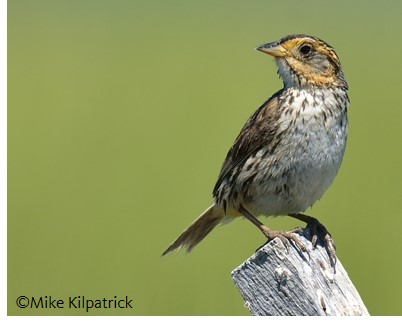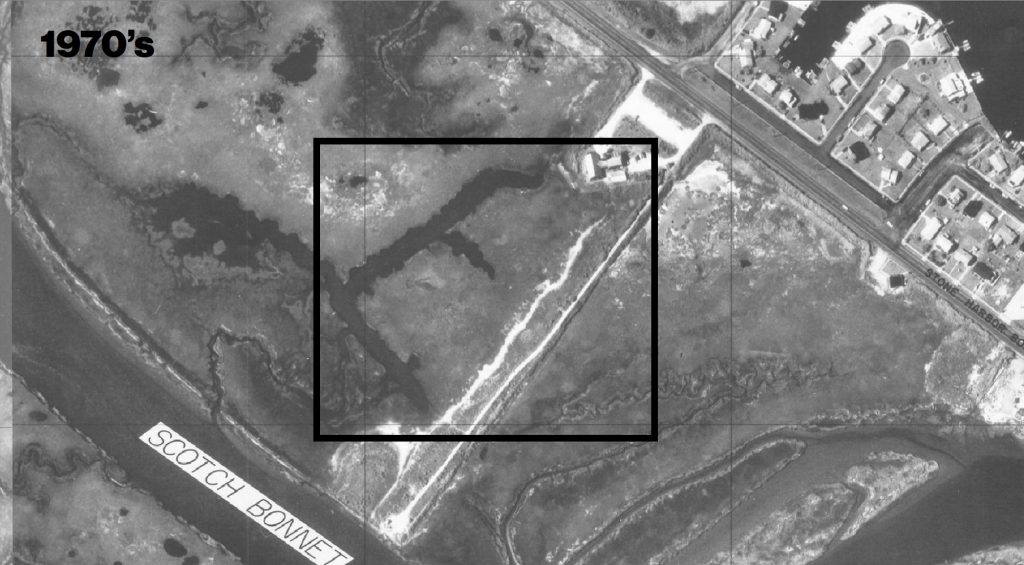
Saltmarsh sparrows in south Jersey are enigmatic, particularly during nesting season. While there is no doubt that they nest in the salt marshes of Cape May County, their distribution and habitats here aren’t well documented.
In Atlantic and Ocean counties, the classic nesting habitat for saltmarsh sparrows is widespread: high marsh vegetation, dominated by Spartina patens.
But in Cape May County, this habitat is scarce.
On Cape May’s Delaware Bay side, the marshes are so altered by past impoundment that much of the natural high marsh has been wiped out.
On the the Atlantic Ocean side of the county, high marsh vegetation seems to be naturally absent, except in a few select areas. Higher areas of marsh are instead dominated by short-form Spartina alterniflora. I suspect that this vegetation pattern is related to tidal range.
Further north in Atlantic County and especially in Ocean County, the tidal range is narrower. In some of the microtidal marshes of Barnegat Bay, high marsh vegetation is extensive and the marshes seem to brim with saltmarsh sparrows.
Based on this apparent lack of habitat, I’ve written off saltmarsh sparrow as a common nester in Cape May County marshes.
A chapter in C. Brooke Worth‘s book Of Mosquitoes, Moths and Mice (published in 1972) has since prompted me to re-examine this assumption.
Upon retirement from a career in medical research at the Rockefeller Foundation, Brooke Worth (1908-1984) bought a farm in Eldora, NJ. It was intended to be his personal research station, where he proceeded to conduct natural history research on a wide range of topics.
Among Worth’s pursuits was a study of sparrows in saltmarshes near Stone Harbor, NJ at the present-day site of the Wetlands Institute.
His study’s intended focus was seaside sparrows, but he soon discovered that small numbers of saltmarsh sparrows were also nesting at the site.
This is puzzling because there is no high marsh vegetation at the site today, and, as far as I know, no nesting saltmarsh sparrows either.
Luckily Worth’s description was detailed enough to pinpoint his exact study area. 1970s aerial photographs (taken during the period when he was finding nests) indicate that the habitat was nearly identical to what it is today.

Brooke Worth’s text confirmed that the saltmarsh sparrows were nesting in Spartina alterniflora, in the same area where seaside sparrows were nesting.
Conventional wisdom, underpinned by seminal studies on these two species, dictates that the two species use distinct habitats, with the seaside content to use alterniflora and the saltmarsh sparrow requiring a dense thatch of patens.
I was convinced of this myself, having spent countless hours at Money Island on the Delaware Bay in Cumberland County studying willets. Despite considerable areas of patchy high marsh vegetation where many willets nested, there were no nesting saltmarsh sparrows. I concluded that the sparrows needed more extensive patches of high marsh for a site to be suitable.
But clearly I led myself astray.
More recently I’ve encountered saltmarsh sparrows in a range of settings during the breeding season. These include extensive patens areas, sites with only patchy patens and sites with only Spartina alterniflora.
eBird indicates that there aren’t many birders submitting lists beyond the well-trodden salt marsh vantage points such as Nummy Island and Jakes Landing. If we limit the time window to June, when sparrows are settled at nesting sites, there are a couple of notable observations.
In 2017, Allison Anholt saw a saltmarsh sparrow carrying food to nestlings on salt marsh that is a stone’s throw from Brooke Worth’s study site. The marsh there has no high marsh with the exception of a narrow band fringing an old revegetated dredge spoil pile.
Back in 2012, Sam Galick got some great photos of salt marsh sparrows in a similar short Spartina alterniflora marsh near Corson’s Inlet.
The New Jersey Breeding Bird Atlas included in New Jersey Audubon’s Birds of New Jersey (1999) indicates four survey blocks in Cape May County, with confirmed nesting in regions where high marsh is scarce.
From this information we conclude that saltmarsh sparrows seem to be eking out a living in a region where their traditional nesting habitat is uncommon.
I have found that these birds are easy to overlook when they are about in small numbers. A few saltmarsh sparrows can get lost among the multitudes of seaside sparrows which are abundant just about everywhere in Cape May County’s marshes.
For example, I’ve visited a salt marsh near Thompsons Beach repeatedly during the nesting season without seeing saltmarsh sparrows. I finally noticed them when a phone call slowed me down. As I stood there over the course of a half hour, saltmarsh sparrows began to show themselves.
Brooke Worth experienced the same thing. He didn’t know saltmarsh sparrows were at his study site until he caught one in a net.
Does the idiosyncratic pattern of habitat use of salt marsh sparrows in Cape May County tell us something new about them?
The species is considered among the most vulnerable to sea level rise. It is strictly a salt marsh nester, and several studies have shown that the high marsh vegetation it depends upon is converting to more flood-tolerant Spartina alterniflora.
Our marshes are subtly changing over time as well and the sparrows may be responding in kind. For example, the nesting saltmarsh sparrows at Brooke Worth’s site don’t seem to be there anymore.
We have scant information on the nesting distribution of saltmarsh sparrows in Cape May, so it goes without saying that we know nothing about their reproductive success compared with more traditional habitats where they occur at higher densities. Often marginal populations get less research attention because they are much harder to study.
Are Cape May County’s salt marsh sparrows indicative of future sparrow apocalypse, where scattered bands of sparrows make use of whatever habitat they can?
There is much yet to learn, but surely time will tell.